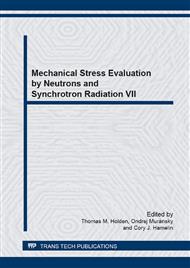p.148
p.155
p.161
p.165
p.171
p.176
p.182
p.188
p.194
Investigation of Residual Stresses Distribution in Titanium Weldments
Abstract:
Titanium and its alloys have increasingly become a material of choice for applications in high-performance structures due to their superior corrosion resistance and high strength-to-weight ratio. However, in contrast to conventional steel alloys, there exist little design and manufacturing experience in the heavy fabrication industry with large welded structures made of titanium materials. In addressing the above concern, the University of New Orleans funded by Office of Naval Research (ONR) initiated program on investigation of manufacturability and performance of a titanium mid-ship section. The uniqueness of this program is its focus upon a representative full-size mid-ship section upon which relevant scientific and technological challenges are simulated and experimentally validated. This paper reports the measurements of residual stresses using neutron diffraction in titanium T-joints. The residual stresses were measured using Engin-X at ISIS (UK) and the Kowari Strain Scanner at ANSTO (Australia). This experimental research was used to validate our in house predictions and significantly improved the knowledge and understanding of the welding process of titanium alloys.
Info:
Periodical:
Pages:
171-175
Citation:
Online since:
February 2014
Authors:
Price:
Сopyright:
© 2014 Trans Tech Publications Ltd. All Rights Reserved
Share:
Citation:


